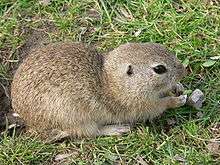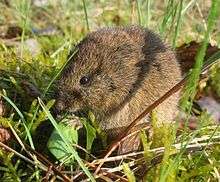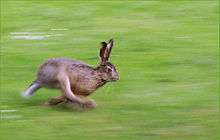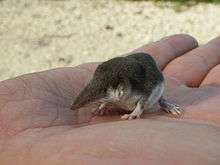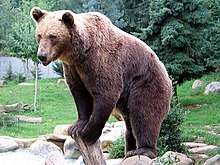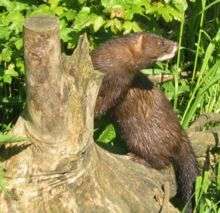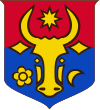List of mammals of Moldova
This list shows the IUCN Red List status of the 32 mammal species occurring in Moldova. One is endangered, four are vulnerable, and three are near threatened. The following tags are used to highlight each species' conservation status as assessed on the respective IUCN Red List published by the International Union for Conservation of Nature:
| EX | Extinct | No reasonable doubt that the last individual has died. |
| EW | Extinct in the wild | Known only to survive in captivity or as a naturalized populations well outside its previous range. |
| CR | Critically endangered | The species is in imminent risk of extinction in the wild. |
| EN | Endangered | The species is facing an extremely high risk of extinction in the wild. |
| VU | Vulnerable | The species is facing a high risk of extinction in the wild. |
| NT | Near threatened | The species does not meet any of the criteria that would categorise it as risking extinction but it is likely to do so in the future. |
| LC | Least concern | There are no current identifiable risks to the species. |
| DD | Data deficient | There is inadequate information to make an assessment of the risks to this species. |
Subclass: Theria
Infraclass: Eutheria
Order: Rodentia (rodents)
Rodents make up the largest order of mammals, with over 40% of mammalian species. They have two incisors in the upper and lower jaw which grow continually and must be kept short by gnawing. Most rodents are small though the capybara can weigh up to 45 kg (99 lb).
- Suborder: Sciurognathi
- Family: Castoridae (beavers)
- Genus: Castor
- Eurasian beaver, C. fiber LC[1]
- Genus: Castor
- Family: Sciuridae (squirrels)
- Subfamily: Xerinae
- Tribe: Marmotini
- Genus: Spermophilus
- European ground squirrel, Spermophilus citellus VU
- Genus: Spermophilus
- Tribe: Marmotini
- Subfamily: Xerinae
- Family: Gliridae (dormice)
- Subfamily: Leithiinae
- Genus: Dryomys
- Forest dormouse, Dryomys nitedula LC
- Genus: Dryomys
- Subfamily: Leithiinae
- Family: Cricetidae
- Subfamily: Cricetinae
- Genus: Cricetulus
- Grey dwarf hamster, Cricetulus migratorius LC
- Genus: Cricetulus
- Subfamily: Arvicolinae
- Genus: Clethrionomys
- Bank vole, Clethrionomys glareolus LC
- Genus: Microtus
- Common vole, Microtus arvalis LC
- European pine vole, Microtus subterraneus LC
- Genus: Clethrionomys
- Subfamily: Cricetinae
- Family: Castoridae (beavers)
Order: Lagomorpha (lagomorphs)
The lagomorphs comprise two families, Leporidae (hares and rabbits), and Ochotonidae (pikas). Though they can resemble rodents, and were classified as a superfamily in that order until the early twentieth century, they have since been considered a separate order. They differ from rodents in a number of physical characteristics, such as having four incisors in the upper jaw rather than two.
- Family: Leporidae (rabbits, hares)
- Genus: Lepus
- European hare, L. europaeus LC[2]
- Genus: Lepus
Order: Erinaceomorpha (hedgehogs and gymnures)
The order Erinaceomorpha contains a single family, Erinaceidae, which comprise the hedgehogs and gymnures. The hedgehogs are easily recognised by their spines while gymnures look more like large rats.
- Family: Erinaceidae (hedgehogs)
- Subfamily: Erinaceinae
- Genus: Erinaceus
- Southern white-breasted hedgehog, Erinaceus concolor LC
- Genus: Erinaceus
- Subfamily: Erinaceinae
Order: Soricomorpha (shrews, moles, and solenodons)
The "shrew-forms" are insectivorous mammals. The shrews and solenodons closely resemble mice while the moles are stout bodied burrowers.
- Family: Soricidae (shrews)
- Subfamily: Crocidurinae
- Genus: Crocidura
- Bicolored shrew, Crocidura leucodon LC
- Lesser white-toothed shrew, Crocidura suaveolens LC
- Genus: Crocidura
- Subfamily: Soricinae
- Tribe: Soricini
- Genus: Sorex
- Eurasian pygmy shrew, Sorex minutus LC
- Genus: Sorex
- Tribe: Soricini
- Subfamily: Crocidurinae
Order: Chiroptera (bats)
The bats' most distinguishing feature is that their forelimbs are developed as wings, making them the only mammals capable of flight. Bat species account for about 20% of all mammals.
- Family: Vespertilionidae
- Subfamily: Myotinae
- Genus: Myotis
- Bechstein's bat, Myotis bechsteini NT
- Pond bat, Myotis dasycneme LC
- Genus: Myotis
- Subfamily: Vespertilioninae
- Genus: Barbastella
- Barbastelle, B. barbastellus VU
- Genus: Nyctalus
- Greater noctule bat, N. lasiopterus NT[3]
- Lesser noctule, N. leisleri NT
- Genus: Pipistrellus
- Common pipistrelle, P. pipistrellus LC
- Genus: Barbastella
- Subfamily: Myotinae
- Family: Rhinolophidae
- Subfamily: Rhinolophinae
- Genus: Rhinolophus
- Greater horseshoe bat, R. ferrumequinum NT
- Lesser horseshoe bat, R. hipposideros LC
- Genus: Rhinolophus
- Subfamily: Rhinolophinae
Order: Carnivora (carnivorans)
There are over 260 species of carnivorans, the majority of which feed primarily on meat. They have a characteristic skull shape and dentition.
- Suborder: Feliformia
- Family: Felidae (cats)
- Subfamily: Felinae
- Genus: Felis
- European wildcat, F. silvestris LC
- Genus: Lynx
- Eurasian lynx, L. lynx LC[4]
- Genus: Felis
- Subfamily: Felinae
- Family: Felidae (cats)
- Suborder: Caniformia
- Family: Canidae (dogs, foxes)
- Family: Ursidae (bears)
- Genus: Ursus
- Brown bear, U. arctos LC[6]
- Genus: Ursus
- Family: Mustelidae (mustelids)
- Genus: Mustela
- European mink, M. lutreola CR[7]
- Stoat, M. erminea LC
- Steppe polecat, M. eversmannii LC
- Least weasel, M. nivalis LC
- European polecat, M. putorius LC
- Genus: Martes
- Beech marten, M. foina LC
- Genus: Meles
- Eurasian badger, M. meles LC[8]
- Genus: Lutra
- European otter, L. lutra NT[9]
- Genus: Mustela
See also
References
- Batbold, J.; Batsaikhan, N.; Shar, S.; Hutterer, R.; Kryštufek, B.; Yigit, N.; Mitsain, G.; Palomo, L. (2016). "Castor fiber". IUCN Red List of Threatened Species. 2016: e.T4007A115067136.
- Hacklande, K.; Schai-Braun, S. (2019). "Lepus europaeus". IUCN Red List of Threatened Species. 2019: e.T41280A45187424. doi:10.2305/IUCN.UK.2019-1.RLTS.T41280A45187424.en.
- Hutson, A. M.; Alcaldé, J. T.; Juste, J.; Karataş, A.; Palmeirim, J. & Paunović, M. (2010). "Nyctalus lasiopterus". IUCN Red List of Threatened Species. 2010: e.T14918A4471682.CS1 maint: multiple names: authors list (link)
- Breitenmoser, U.; Breitenmoser-Würsten, C.; Lanz, T.; von Arx, M.; Antonevich, A.; Bao, W. & Avgan, B. (2015). "Lynx lynx". IUCN Red List of Threatened Species. IUCN. 2015: e.T12519A121707666.
- Boitani, L.; Phillips, M. & Jhala, Y. (2018). "Canis lupus". IUCN Red List of Threatened Species. IUCN. 2018: e.T3746A119623865. doi:10.2305/IUCN.UK.2018-2.RLTS.T3746A119623865.en.CS1 maint: multiple names: authors list (link)
- McLellan, B. N.; Proctor, M. F.; Huber, D. & Michel, S. (2017). "Ursus arctos". IUCN Red List of Threatened Species. IUCN. 2017: e.T41688A121229971. doi:10.2305/IUCN.UK.2017-3.RLTS.T41688A121229971.en.
- Maran, T.; Aulagnier, S.; Libois, R.; Kranz, A.; Abramov, A. & Wozencraft, C. (2010). "Mustela lutreola". IUCN Red List of Threatened Species. 2010: e.T14018A4381596.
- Kranz, A.; Abramov, A. V.; Herrero, J. & Maran, T. (2016). "Meles meles". IUCN Red List of Threatened Species. IUCN. 2016: e.T29673A45203002.
- Roos, A.; Loy, A.; de Silva, P.; Hajkova, P.; Zemanová, B. (2015). "Lutra lutra". IUCN Red List of Threatened Species. IUCN. 2015: e.T12419A21935287. doi:10.2305/IUCN.UK.2015-2.RLTS.T12419A21935287.en.
External links
- "Animal Diversity Web". University of Michigan Museum of Zoology. 1995–2006. Retrieved 22 May 2007.
